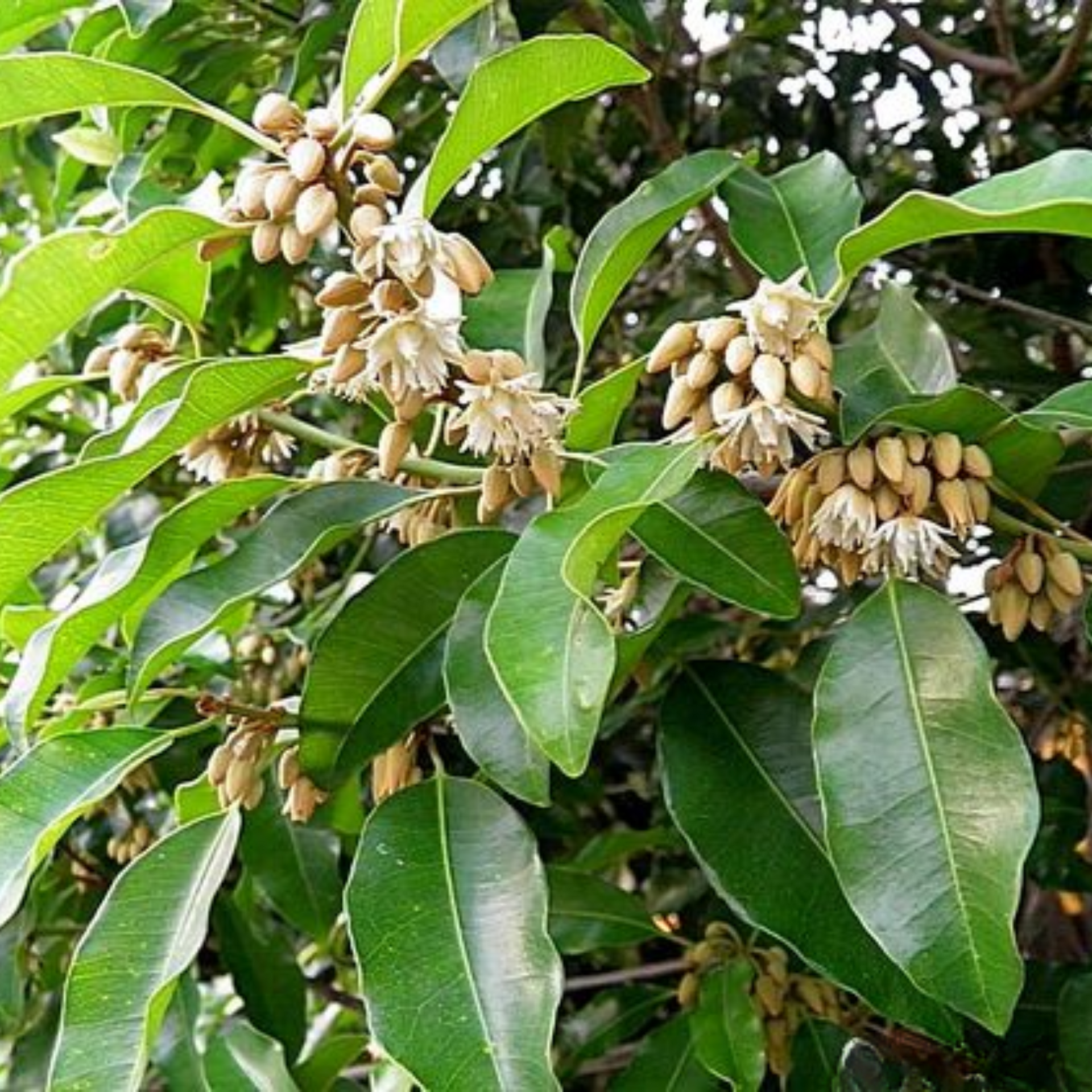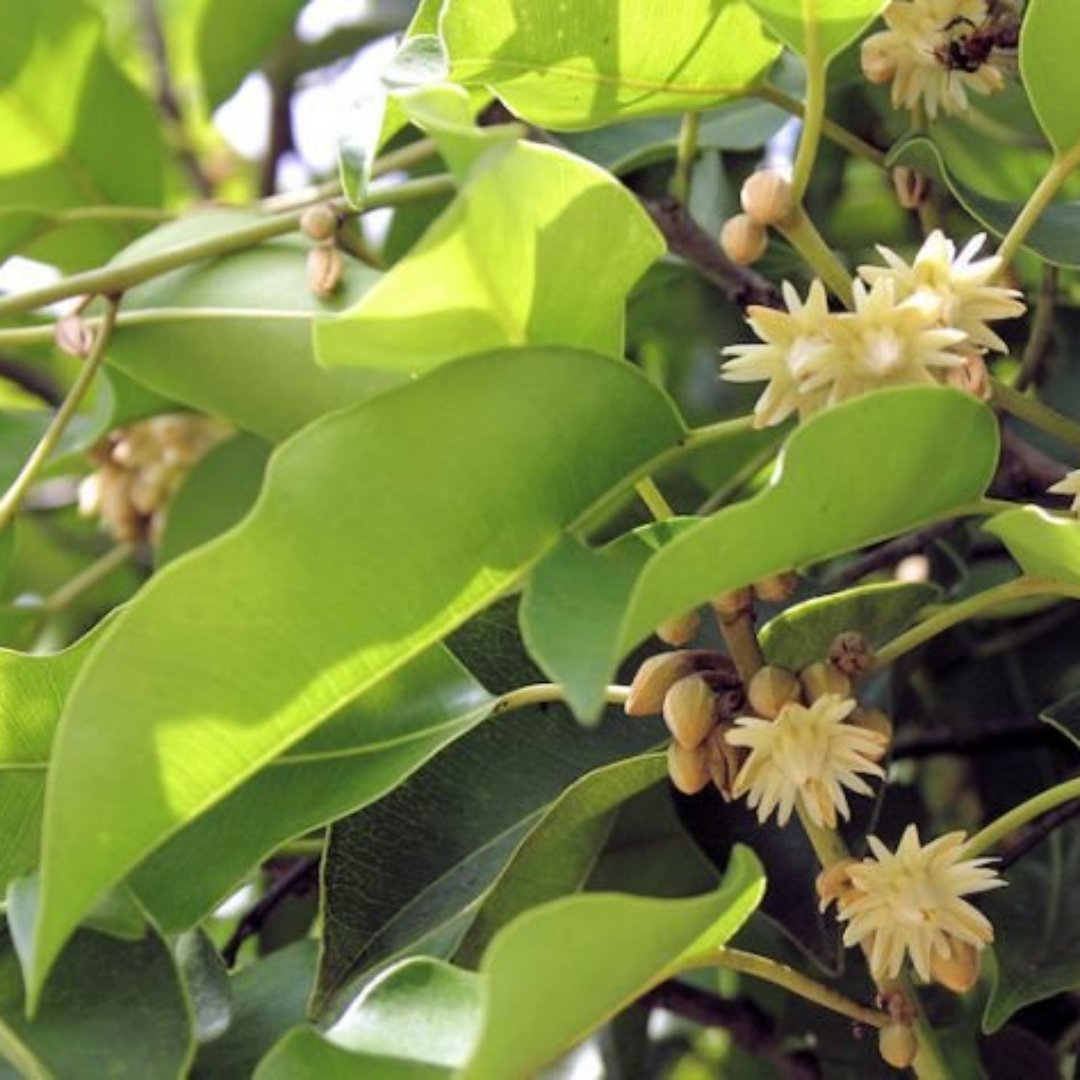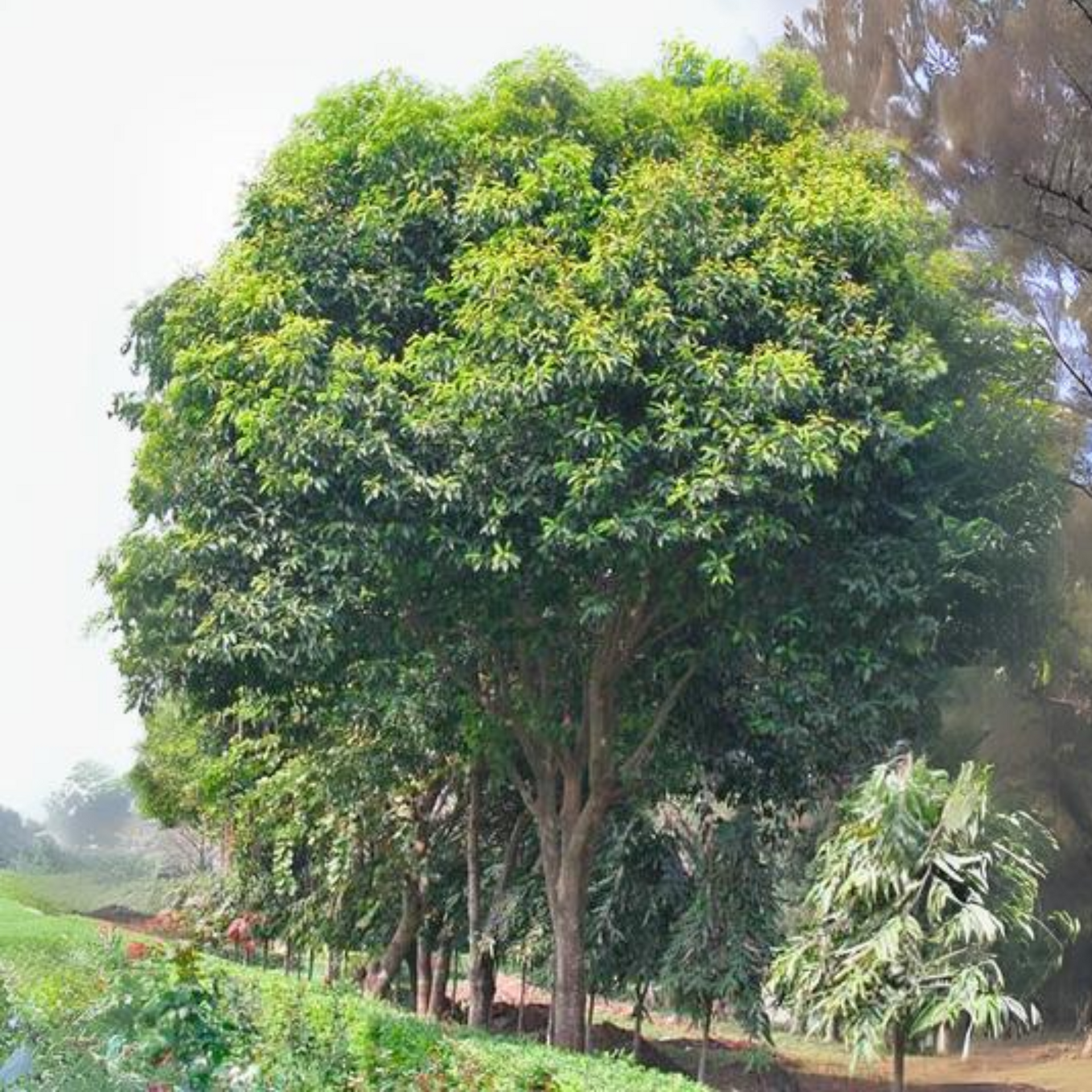


Bakul tree Mimusops elengi Borsalli Plant
Guaranteed Safe Checkout
Green Paradise Offers Healthy Bakul Borsalli Palnt
About Bakul Borsalli Plant
Bakula Is An Amazing Factory With Lots Of Medicinal Uses And Also habituated For Creating Bonsai.
Mimusops elengi has been too important in the news for its growing demand. The Bakula Pushpa factory has lots to offer and is also called Indian Medlar or Bulletwood tree when it comes to remedial benefits. still, Indians stranger to its salutary parcels for hair care and skin care. Known as Bakula to us, back home, this tree finds citation in the ancient Holy Writ of Ayurveda as well.
Bakula has a fresh and sweet-smelling fragrance. It's an evergreen tree and it has a distinctive appearance due to its dark dinghy with deep crevices. The dinghy is red on the inside whereas the sanguine-slate dinghy, which is hardy, makes up the external part. Bakula trees grow throughout the country and have smooth and candescent leaves.
The flowers grow in bunches and are fragrant. They're white in color with an unheroic-ish tincture. The scent can be retained for time if the flowers are sun-dried and saved well. Women use dried flowers to make necklaces and other accessories. the fruits of the trees are round-shaped and green in color when raw. The fruits turn yellow on ripening. The matured fruits are candescent and come gray-brown. Birds Love Thes Fruits. They would have generally 1 or 2 seeds and are acidulous in maturity. The blooms bloom in April, while the fruits appear in June.
Bakul is a beautiful flowering tree native to the Indian subcontinent and other Southeast Asian countries. It is highly regarded for its fragrant flowers, which are used in various cultural and religious practices.
Here are some key features of the Bakul plant:
Appearance:
The Bakul tree is an evergreen with glossy, dark green leaves that are lance-shaped and arranged alternately along the branches. It can grow up to 25 meters (82 feet) tall in its natural habitat, though smaller varieties are also cultivated.
Flowers:
The flowers of the Bakul are the tree's most striking feature. They are small, star-shaped, and waxy with a delightful fragrance that is intense and sweet, often compared to that of jasmine. The flowers are white to cream in color, and they appear in clusters at the end of branches. Their scent is especially potent at night, making the tree a popular choice for gardens and landscapes, as it perfumes the air.
Fruit:
After the flowers, Bakul trees produce small, green, olive-like fruits. The fruits are edible but not commonly consumed by humans. They are more often consumed by birds and wildlife.
Cultural and Religious Significance:
The Bakul tree holds cultural and religious significance in various traditions. In Hinduism, its flowers are offered to deities in temples and are often used in garlands and religious rituals. The fragrance of the Bakul flowers is associated with love and sensuality in Indian poetry and literature.
Medicinal Uses:
Different parts of the Bakul tree, including the bark, leaves, and flowers, have been used in traditional medicine for various purposes. For instance, the bark is believed to have astringent properties and is used for treating certain skin conditions and diarrhea.
Growing Conditions:
Bakul trees prefer a tropical or subtropical climate. They grow well in well-draining, fertile soil and require regular watering. They can tolerate both full sunlight and partial shade. While they can be grown from seeds, propagation is more commonly done through stem cuttings or grafting to maintain desirable traits.
Landscape Use:
Due to its aesthetic appeal and fragrant flowers, the Bakul tree is often planted in gardens, parks, and along streets in suitable regions. Its ability to attract birds and butterflies adds to its ornamental value.
Cultural Names:
In addition to "Bakul," the tree is known by various names in different languages and regions. For example, it is called "Maulsari" in Hindi and "Magizham" in Tamil.
Bakul is a tree that holds both cultural and horticultural significance, making it a beloved plant in the regions where it is cultivated. It's enchanting fragrance and elegant appearance make it a desirable addition to any garden or landscape, especially for those who appreciate plants with cultural and symbolic significance.
Bakula Tree, Bark, Fruits, and Flowers Have Medicinal Properties
The flowers are used to prize an unpredictable oil painting while the fruits and seeds are used for their phytoactive composites similar to quercitron, ursolic acid, triterpene alcohol, di- hydro quercetin, and further.
Bakula fruits are thought to provide relief from diarrhea as well as tooth disorders such as cavities and gunk.
The delicate stems are used to make toothbrushes, and the bark powder can be used as a tooth exfoliant.
Gargling with the result of its dinghy grease paint and Acacia catechu is veritably salutary for bleeding epoxies and blown epoxies.
The flowers have anti-inflammatory and healing properties.
Bakula Tree for Religious Purposes:
During the 21-pushpa pooja, Lord Ganesha is presented with Bakula flowers. The flowers are considered to be veritably sacred in Jainism and Buddhism.
Plant Specification
Height: 20-30cm
Maximum Reachable Height: Up to 20 ft
Common Name: Bakul, Maulsari, Vajradhanthi, Spanish cherry
Planting and care
Planting:
Climate:
Bakul thrives in tropical and subtropical climates. It prefers warm temperatures and does well in areas with temperatures between 20°C to 35°C (68°F to 95°F).
Sunlight:
Bakul prefers full to partial sunlight. It should be planted in a spot that receives at least 4-6 hours of direct sunlight daily.
Soil:
The plant prefers well-draining soil with a slightly acidic to neutral pH level. It can tolerate various soil types but thrives in fertile and loamy soils.
Planting Time:
The best time to plant Bakul is during the spring or early monsoon season when the weather is warm and favorable for growth.
Propagation:
Bakul can be propagated from seeds or stem cuttings. If planting from seeds, soak them in water for a day before sowing to improve germination rates.
Planting Depth:
When planting seeds or cuttings, make a hole in the soil that is large enough to accommodate the root ball. Place the plant in the hole and backfill with soil, gently firming it around the plant.
Care:
Watering:
Regular watering is essential, especially during the dry season or when the plant is young and establishing its root system. However, ensure that the soil doesn't become waterlogged, as Bakul prefers well-draining soil.
Mulching:
Apply a layer of organic mulch around the base of the tree to conserve moisture, suppress weed growth, and provide nutrients to the soil.
Fertilizer:
Bakul trees generally don't require excessive fertilization. However, you can apply a balanced, slow-release fertilizer during the growing season to promote healthy growth.
Pruning:
Prune Bakul trees to remove dead or diseased branches and maintain the desired shape. Regular pruning can also help improve air circulation and sunlight penetration, leading to healthier growth.
Pest and Disease Control:
Keep an eye out for common pests like aphids and scale insects. Infestations should be treated with insecticidal soap or neem oil as soon as feasible. Proper watering and good air circulation can also help prevent some fungal diseases.
Protection from Extreme Conditions:
Bakul can tolerate moderate drought once established, but it's best to provide adequate water during prolonged dry spells. Additionally, protect young plants from strong winds and frost, as they can be sensitive to these conditions.
Harvesting Flowers:
If you're growing Bakul for its fragrant flowers, you can harvest the blossoms when they are fully open. The flowers are used to make garlands, perfumes, and traditional herbal remedies.
By following these planting and care tips, you can grow a healthy and beautiful Bakul tree in your garden or landscape, enjoying its delightful fragrance and aesthetic appeal.
Fertilize a factory substantially in the spring season.
Water a plant when the soil feels dry to the touch. Water thoroughly in the summer and reduce watering for the winter & rainy seasons.
How To Grow Bakul Borsalli Plant
The Bakul plant is a beautiful evergreen tree native to the Indian subcontinent. It is known for its fragrant flowers and has cultural significance in many regions.
Here are some general guidelines on how to grow Bakul:
Climate:
Bakul thrives in tropical and subtropical climates. It prefers warm temperatures and does well in areas where the temperature does not drop below 50°F (10°C).
Sunlight:
Bakul trees prefer full sun to partial shade. They will grow well in a spot that receives at least 4-6 hours of direct sunlight daily.
Soil:
Well-draining soil is crucial for Bakul plants. They prefer slightly acidic to neutral soil with a pH level between 6.0 to 7.5. Ensure the soil is rich in organic matter.
Watering:
While Bakul is relatively drought-tolerant once established, it requires regular watering during the early stages of growth. Water the soil just enough to keep it moist but not saturated.
Planting:
If you're starting with a young Bakul plant, choose a location with enough space for it to grow. Dig a hole twice the size of the root ball and gently place the plant in it. Fill the hole with soil, pat it down gently, and water thoroughly.
Mulching:
Apply a layer of organic mulch around the base of the plant to retain moisture, suppress weeds, and keep the soil cool.
Fertilization:
Bakul trees benefit from regular fertilization. Use a balanced, slow-release fertilizer during the growing season (spring and summer) to promote healthy growth and flowering.
Pruning:
Prune Bakul trees as needed to maintain their shape and remove any dead or diseased branches. The best time for pruning is after the flowering period.
Propagation:
Bakul can be propagated through seeds or stem cuttings. If using seeds, plant them in a well-draining seed-starting mix, and keep the soil consistently moist until germination occurs. For stem cuttings, take 6-8 inch (15-20 cm) long cuttings from healthy branches, remove the lower leaves, and plant them in a mix of perlite and peat moss.
Pests and Diseases:
Bakul trees are generally resistant to pests and diseases, but like any plant, they can be susceptible to certain issues. Monitor your plant regularly and treat any problems promptly if they arise.
Flowering:
Bakul produces small, creamy-white, star-shaped flowers with a strong, sweet fragrance. The flowers are often used in making garlands and perfumes.
Remember that growing a tree-like Bakul requires patience, as it may take several years for the plant to mature and start flowering. Additionally, local climate and environmental conditions can influence the success of your Bakul plant. Always observe and adapt your care routine based on the specific needs of your plant.




